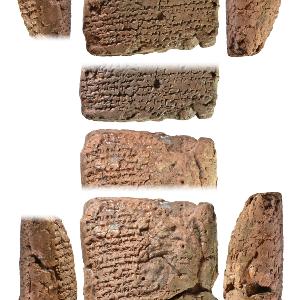Mesopotamia: digital storehouse for hidden knowledge
3 Mar 2023
Another highlight of Ancient Near East research in Munich: a new Bavarian Academy of Sciences project digitizes cuneiform tablets from Iraq Museum.
3 Mar 2023
Another highlight of Ancient Near East research in Munich: a new Bavarian Academy of Sciences project digitizes cuneiform tablets from Iraq Museum.

contributes to making the corpus of thousands of years old cuneiform tablets from Mesopotamia accessible. | © Jan Greune/LMU
The Iraq Museum in Baghdad safekeeps our knowledge about the early urban civilizations in Mesopotamia. Tens of thousands of texts are housed there, revealing how the people in the once thriving cities lived, worked, conducted wars, and died. As was the practice in those times, the texts were written in cuneiform signs on clay.
“The museum is home to all clay tablets and fragments that have been uncovered during excavations in Iraq since 1936. These tablets and fragments contain knowledge about ancient Mesopotamia from Assur to Babylon,” says Professor Walther Sallaberger, Chair of Assyriology at LMU’s Institute of Assyriology and Hittite Studies. The artefacts cover the entire epoch of cuneiform culture from its beginnings at the end of the fourth millennium BC to the dawn of the Christian era.
Whereas other museums often contain objects dug up in illicit excavations, for which contextual information is lacking, there is precise archaeological data available for the artefacts in the Iraq Museum. As such, scholars have access to the context of the text they are studying, such as the former city it comes from, even the exact house where it was found.
This is very valuable information for researchers, as it allows them to situate the specific artefact in its original environment. “This is very important in the case of archival documents. But it’s also significant for the analysis of literary texts,” says Sallaberger.

Written in cuneiform characters on clay, the text calls on future kings and magnates to be mindful of justice. The manuscript comes from the city of Nippur, 8th century BC. | © Projekt „Cuneiform Artefacts of Iraq in Context“ (CAIC)/LMU
Taken by themselves, archival documents can seem rather dry and pedestrian when dealing with things like the sale of grain or individual administrative acts. In their totality, however, they afford detailed glimpses into the lives of people from past cultures. They tell us, for example, what people used to eat, how much certain kinds of labor were worth, who had power, and who married whom. Access to written documents from Mesopotamia, where the first city in the world once arose, and where advanced cultures and world empires rose and fell, therefore allows researchers to explore a wide variety of questions.
Together with Professor Enrique Jiménez at the Institute of Assyriology and Hittite Studies and Professor Karen Radner, who holds the Alexander von Humboldt Chair of Ancient History of the Near and Middle East at LMU, Walther Sallaberger heads the “Cuneiform Artefacts of Iraq in Context” project at the Bavarian Academy of Sciences and Humanities. All three researchers have many years of experience with projects on site and have contacts in Iraq – “exceptional in this density,” observes Sallaberger. The team also includes five Assyriologists and an expert in digital humanities.
There will also be a scholarship program, which will see Iraqi scientists coming to Munich on research visits and gaining experience in the digital editing of cuneiform texts. “This is important for a country that, due to political circumstances, was largely cut off from the world and the latest scientific developments for almost 30 years,” says Walther Sallaberger.
The strength of the project is the digital aspect.Walther Sallaberger, Chair of Assyriology at LMU’s Institute of Assyriology and Hittite Studies
The goal of the project is to preserve the cultural heritage of Mesopotamia, the ancient region situated in modern-day Iraq and Syria. Members of the project team will photograph, digitize, conserve, and, if necessary, restore the artefacts. Dried clay is very hard and can survive for millennia, but clay tablets can also crumble and break apart once excavated. Therefore, the team is working with a restorer on site.
“The strength of the project is the digital aspect,” emphasizes Walther Sallaberger. This component is based on the Electronic Babylonian Library database, that is to say, “the most advanced platform in cuneiform research.” Originally created for literary texts by his colleague Enrique Jiménez at the institute, it is now being further developed so that it can also digitize official documents and the data on persons and context associated with them.
To this end, the project will not only digitize the texts, but also translate and lexically classify them, creating lists of vocabulary and opening up various avenues of access to researchers studying specific aspects.
The plan is for the database, through gradual accumulation, to contain everything that is known about Mesopotamia in the relevant fields, such that it will mirror the latest state of research: “Our goal is to combine the corpus of cuneiform tablets and the knowledge hidden within it and to render them accessible,” says Walther Sallaberger. The Ancient Near East specialist hopes that researchers and laymen alike with an interest in a specific aspect will then easily be able to consult the database and call up all publications and information that exist on the subject along with related links for further exploration.
The official opening of the “Cuneiform Artefacts of Iraq in Context” project will take place at the Bavarian Academy of Sciences and Humanities on 3 March 2023.
Article on Prof. Walther Sallaberger’s research in Insights magazine (German only: pdf, p. 30: Im Spiegel der Schrift):
Leibniz Prize for LMU researcher Karen Radner